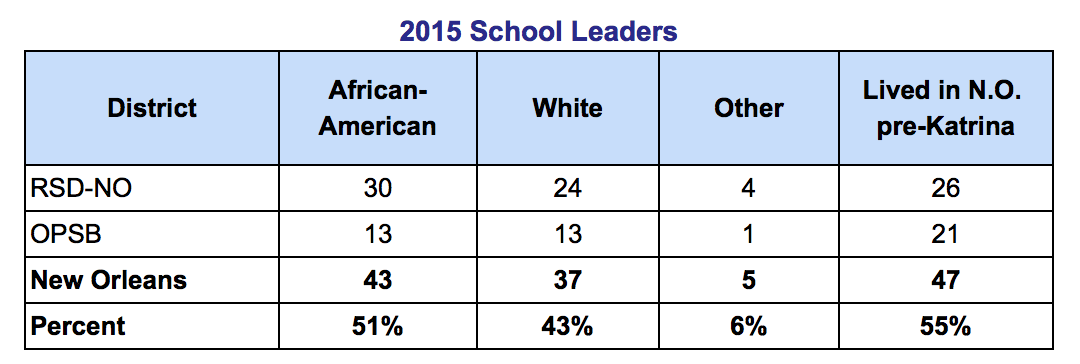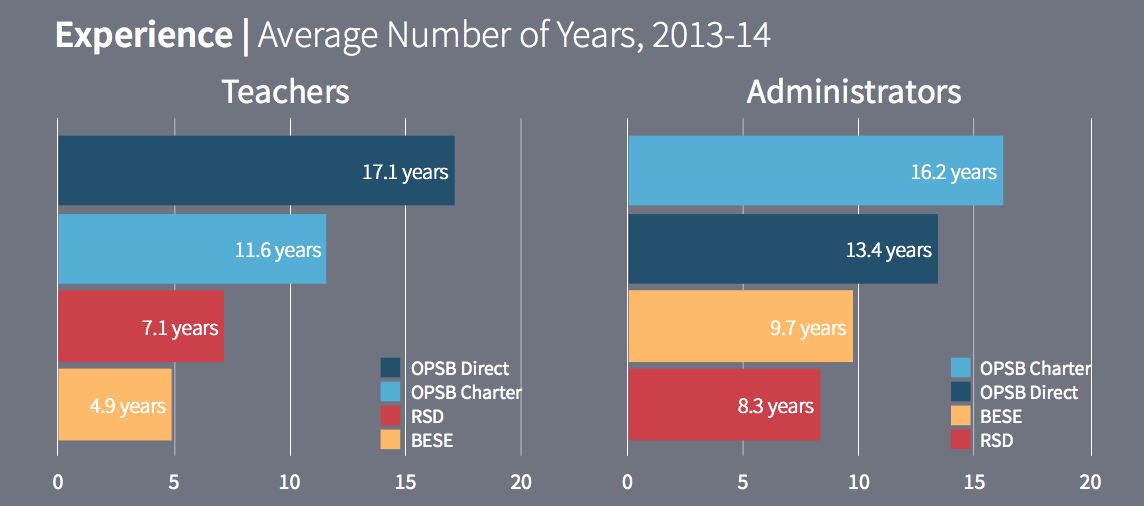Well, Andrea Gabor is at it again.
A few years ago, Andrea Gabor wrote an article for Newsweek that maligned the transformation of New Orleans’ public schools since Hurricane Katrina. At the time, I wrote a response that exposed the “inaccuracies, misrepresentations, and glaring omissions of fact” in her Newsweek piece – issues that made it abundantly clear that Gabor was “pushing her political agenda at the expense of her journalistic principles.”
Now, as we prepare to mark the 10th Anniversary of Katrina, Gabor has taken to the pages of the New York Times to add insult to injury with “The Myth of the New Orleans School Makeover,” another cheap shot at the accomplishments of so many hardworking New Orleans educators.
Once again, I feel compelled respond. Below, I set the record straight on several of the misleading points Gabor makes in her latest attack.
I. On the State Take Over…
First of all, Gabor manages to get many of the basic facts wrong in her opinion piece. For example, Gabor states:
“Two years before the storm, the State of Louisiana had set up a so-called Recovery School District to take over individual failing schools. After Katrina, the district eventually took over about 60 local schools; about 20 well-performing schools remained in the Orleans Parish School Board, creating, in essence, a two-tier system.”
In fact, the Recovery School District (RSD) took over 102 out of 126 schools from the Orleans Parish School Board (OPSB) in late-November 2005. Of the remaining 24 schools, seven were uninhabitable, 12 became charters, and five remained directly managed by OPSB.
Moreover, the schools that escaped state take over were nearly all selective-admissions magnet schools, the beneficiaries of the two-tiered public education system that existed in the city before Katrina. As education activist and New Orleans native Chris Stewart wrote:
“New Orleans has always had schools that screened out poor kids to create enclaves for the black elite and the sons and daughters of bankers and doctors. I know what the other side of that coin looks like having attended schools for the other people.”
If anything, the Recovery School District’s work to improve New Orleans schools over the past decade is an attempt to rectify this inequitable history.
II. On Louisiana’s Standards…
While conceding that proficiency, high school graduation, and college entry rates have all risen in New Orleans over the past ten years (no small matters), Gabor attempts to diminish these accomplishments by claiming:
“But the New Orleans miracle is not all it seems. Louisiana state standards are among the lowest in the nation.”
Apparently, Professor Gabor has somehow missed the extensive national media coverage [for example, in the New York Times, Politico, Washington Post, Talking Points Memo, and even Gawker] of the battle between State Superintendent John White and Governor Bobby Jindal over the Common Core State Standards, which Louisiana adopted in 2012.
In short, the contention that Louisiana state standards are among the lowest in the nation is, to borrow Gabor’s own words, “simply false.”
III. On the Education Research Alliance Studies…
Gabor cites two studies from the Education Research Alliance for New Orleans at Tulane University to bolster her claim that “stark problems remain”:
“A recent report by the Education Research Alliance confirmed that principals engage in widespread “creaming” — selecting, or counseling out, students based on their expected performance on standardized tests. In a forthcoming study, the alliance expects to show that lowest-scoring students are less likely to move to higher-performing schools.”
As I noted in a previous post, the first study referenced by Gabor was based on data from the 2012-13 school year. Since that time, OneApp – the RSD’s city-wide enrollment system – has made the “creaming” concerns she raises irrelevant, as schools no longer have the opportunity to either select or counsel out students.
Interesting results from @Era_NOLA research on the difficult question of whether or not to close schools? #NOLAed pic.twitter.com/SsJBi0jgH1
— Peter C. Cook (@petercook) June 20, 2015
The second, forthcoming study that Gabor mentions looked at what happens to students at charters that are closed for low performance. Ironically, both Gabor and I attended the session at the ERA conference that presented the results from the study, which actually found that most students impacted by closures end up at higher performing schools. How Andrea Gabor could construe these results so negatively is beyond me, but you can watch the presentation below and try to figure it out yourself.
IV. On Disadvantaged and Disappearing Children…
Two of Gabor’s favorite (and vague) claims about New Orleans is that the reforms have left behind the city most disadvantaged students, as well as excluded large numbers of young people who have simply dropped out of the system. For example:
“There is also growing evidence that the reforms have come at the expense of the city’s most disadvantaged children, who often disappear from school entirely and, thus, are no longer included in the data.”
and,
“One problem is that in the decentralized charter system, no agency is responsible for keeping track of all kids…Louisiana’s official dropout rates are unreliable, but a new report by Measure of America, a project of the Social Science Research Council, using Census Bureau survey data from 2013, found that over 26,000 people in the metropolitan area between the ages of 16 and 24 are counted as ‘disconnected,’ because they are neither working nor in school.”
Gabor’s contention that New Orleans’ reforms have left behind the city’s most disadvantaged kids seems hard to square with the fact that the performance of special needs students has increased dramatically over the past ten years. In fact, special needs students in New Orleans are graduating from high school at a much higher rate than their peers statewide.

Furthermore, Gabor’s claim that “no agency is responsible for keeping track of all kids” will no doubt come as a surprise to officials at the RSD and Louisiana Department of Education, the two agencies that are, in fact, charged with keeping track of students in New Orleans’ public schools.
Here’s how officials keep track of students:
- At the high school level, LDOE’s accountability measure includes the cohort graduation rate. Schools get credit for ensuring that every student graduates high school within 4 years. If a student does not graduate, the last school of record for that student loses points on its School Performance Score (SPS).
-
At the elementary school level, LDOE’s accountability measure includes points for students who enroll in the 9th grade and achieve enough credits to move to the 10th grade. This pushes elementary schools to ensure that 8th graders are successfully transitioning to high school.
-
The RSD simultaneously tracks students who are excessively truant through its Youth Opportunity Center (YOC). The YOC is staffed by social workers who partner with schools to identify students who have registered for school but have not attended, students who have a significant number of absences, and students who are adjudicated or hospitalized. Once identified, social workers then support these students to get them back on the pathway to school.
V. On Minority Participation…
Gabor raises an oft-repeated claim by reform opponents that minorities – in particular, African-Americans – have been excluded from school leadership positions as a result of the reforms:
“Meanwhile, black charter advocates charge that the local charter ‘club’ leaves little room for African-American leadership. Howard L. Fuller, a former Milwaukee superintendent, said the charter movement won’t have ‘any type of long-term sustainability’ without meaningful participation from the black community.”
She also states that the reforms have replaced African-American educators with young, white, inexperienced teachers:
“A key part of the New Orleans narrative is that firing the unionized, mostly black teachers after Katrina cleared the way for young, idealistic (mostly white) educators who are willing to work 12- to 14-hour days.”
Fortunately, the actual facts on the ground make clear this isn’t the case at all. Not only are a majority of the city’s school leaders people of color, but more than half of them lived in New Orleans prior to Hurricane Katrina.

In addition, the city’s teaching corps is far more diverse and experienced than Gabor would lead readers to believe. In 2013, the most recent year for which data are available, 54% of teachers in New Orleans’ public schools were African-American. Teachers in the RSD had, on average, 7.1 years of experience in the classroom; in OPSB charters and direct-run schools, those figures were 11.6 and 17.6 years of experience, respectively.

VI. On The Lessons From New Orleans…
Finally, the most infuriating statement in Gabor’s entire piece is her conclusion:
“For outsiders, the biggest lesson of New Orleans is this: It is wiser to invest in improving existing education systems than to start from scratch. Privatization may improve outcomes for some students, but it has hurt the most disadvantaged pupils.”
A note to Professor Gabor: We didn’t have a choice between improving our school system or starting from scratch. Our school system, our homes, our livelihoods were wiped out in a flood that covered over 80% of New Orleans.
In the aftermath of our nation’s greatest disaster, we came together to rebuild our great city, but we refused to rebuild a school system that had marginalized the poorest children in our community for far too long. Instead, we embarked on a new vision for public education in New Orleans and we took a path that doesn’t dovetail with the prerogatives of education reform opponents like Andrea Gabor.
Today, a decade after Katrina, tens of thousands of children are receiving a better education and have vastly improved life opportunities because of our collective work – and a pessimistic screed in the New York Times is never going to change that fact.



.@petercook Book is mostly positve. JUST SAY NO—isnt that more approp 2 Putin’s Russia than democ? R u more intersted in PR than vig debate?
@petercook @aagabor When your big anti-edu story is debunked and shown to be tripe? Write a book. Guaranteed sales via Ravitch book club
@petercook @Mr_Ankrum @kari_upstate212 @sowhesed @EdCitizen thx for this. Read #6 will read rest after work
@Kiwigirl58 Never heard of her…;^) @KHRoyal @DrCamikaRoyal @SarahWAZZU @citizenstewart
@petercook did you check out @KHRoyal? @DrCamikaRoyal @SarahWAZZU @citizenstewart
@Kiwigirl58 I would talk to someone who doesn’t live here? Oh, OK shaman. Thanks. @KHRoyal @DrCamikaRoyal @SarahWAZZU @citizenstewart
@petercook the EXPERT on NOLA is @KHRoyal… if you were serious, you could also talk to @DrCamikaRoyal; @SarahWAZZU @citizenstewart
.@petercook @nytimes, thanks go to you. Dunno how respectable paper can publish such error-laden article.
.@petercook thank you for setting the record straight. Dunno how @nytimes can publish such a misleading piece. peterccook.com/2015/08/23/gab…
@JSlakov Fixed – thanks for the heads-up.
@petercook Several of your links don’t work